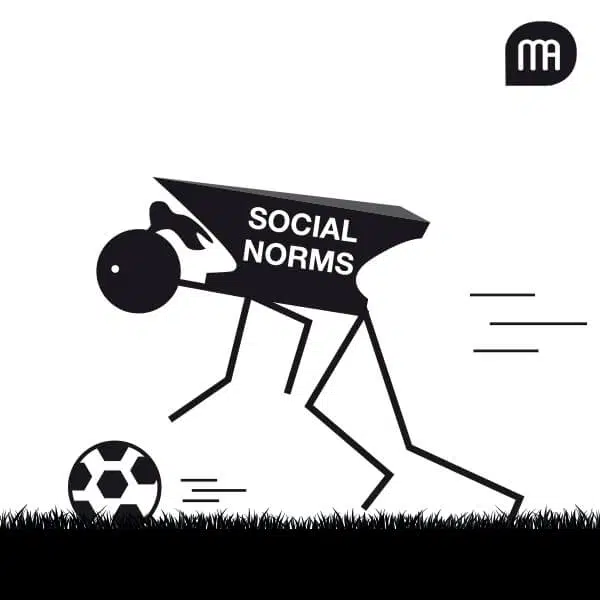
“[…] Homo socio-economicus is simultaneously ‘an independent free being and a dependent social being’ (Schuyler, 1953). For homo socio-economicus, justice and charity are the ultimate principles. Pesch rejects the homo economicus of conventional market economics, affirming instead that ‘individuals are human persons, subjects (bearers) of the same metaphysical human nature by reason of which all persons are ordained to all values pertaining to humanity, including economic values’ (Gundlach, 1951).” (5)
Let us now consider two other formulas: Homo hierarchicus and Homo aequalis. Dedicated to Louis Dumont, these expressions characterise the man whose conduct is (in part) determined by the type of society in which he lives. At the beginning of Homo aequalis, published in 1977, Dumont clarified the origins of these two expressions after noting that “the true types of men that can be distinguished within the species are social types:”
“The type corresponding to the caste society [in Homo hierarchicus, published in 1966, Dumont had studied the caste system in India] is essentially characterised by its submission to hierarchy as the supreme value, exactly the opposite of the egalitarianism that reigns, as one of their cardinal values, in our modern type societies.” (6)
Let us move on to Homo ludens. Johan Huizinga places this being on the same level as Homo sapiens and Homo faber (the man who makes things). He noted that
“[…] Even in its simplest forms on the animal level, play is more than a mere physiological phenomenon or a psychological reflex. It goes beyond the confines of purely physical or purely biological activity. It is a significant function-that is to say, there is some sense to it. In play there is something ‘at play’ which transcends the immediate needs of life and imparts meaning to the action.” (7)
What about Homo psychologicus? For Ralf Dahrendorf, this theoretical being is “the second ‘man’ of social science” after Homo economicus (8). Created (according to Dahrendorf) by Sigmund Freud, Homo psychologicus is, in his words, “the man who even if he always does good may always want to do evil – the man of invisible motives who has not become the more familiar for our having made him into a kind of party game.” There are of course less ironic ways of considering Homo psychologicus, but that of Martin Seligman and his colleagues does not work in his favour either:
“The canonical human being, Homo psychologicus, is a prisoner of the past and the present. If you want to know what humans will do in the future, all you need to know are four things:
1. Their history
2. Their genetic makeup
3. The present stimuli
4. The present drives and emotions.” (9)
If Seligman and his colleagues insist on predicting a person’s conduct, it is because they consider that the prospective capacity of the human being, i.e. his ability to act according to forward-looking representations, is the hallmark of Homo sapiens:
“[…] We believe that the unrivaled human ability to be guided by imagining alternatives stretching into the future – “prospection” –uniquely describes Homo sapiens.”
And they add that “prospection is the actual ability that, at its best, makes the aspiration of wisdom a reality. Hence, we are better named Homo prospectus.” Ralf Dahrendorf clearly indicates that this theoretical being is a reduction, a model of reality, a pure “scientific construct.” Indeed, “Every discipline,” he argues, “if it is to make its statements precise and testable, must reduce its huge subject matter to certain elements from which may be systematically construed, if not a portrait of reality of experience, then a structure in whose tissue a segment of reality may be caught.” (8) As for Homo sociologicus, it is located at the junction between the sphere of the individual and the social world. Dahrendorf insists on the fact that a category or concept must necessarily be assumed in order to give reality to this junction. In Dahrendorf’s view, this concept is that of “role:”
“At the point where individual and society intersects stands homo sociologicus, man as the bearer of socially predetermined roles.”
In order to justify this definition, Dahrendorf adds that “to a sociologist the individual is his social roles.” This is where Homo sociologicus has some relevance. In the previous post, the role of women footballers was discussed – not their narrow (but real) role as participants in a sporting activity, but the fact that they are the object of social expectations – that they occupy a genuine social role. In this sense, the expression Homo sociologicus is rather well adapted to their present situation and status. Alain Anquetil (1) Formulas such as “Homo Sociologicus” have been constructed from those that use “Homo” to name genera of hominids (e.g. Homo sapiens, Homo erectus and Homo abilis). (2) E. E. Williams & M. Chapman Findlay III, “A reconsideraton of the rationality postulate,” American Journal of Economics and Sociology, 40(1), 1981, pp. 18-19. Quoted by Amitai Etzioni, The moral dimension, toward a new economics, New York: The Free Press, 1988. (3) T. O. Nitsch, “Economic man, socio-economic man and Homo-economicus humanus,” International Journal of Social Economics, 9(6/7), pp. 20-49. (4) E. J. O’Boyle, Personalist economics: Putting the Acting Person at the center of economic affairs, Mayo Research Institute, révisé en juillet 2014. URL: www.mayoresearch.org/files/PERSONALIST%20ECON%20III.pdf (5) E. J. O’Boyle, Personalist economics: Moral convictions, economic realities, and social Action, New York, Springer Science+Business Media, 1998. Boyle cite Joseph B. Schuyler, “Heinrich Pesch, S.1.: 1854-1926,” Social Theorists, C. S. Mihanovich (ed.), Milwaukee, The Bruce Publishing Company, 1953, and Gustav Gundlach, “Solidarist Economics: Philosophy and Socio-Economic Theory in Pesch,” Social Order, 1(4), April 1951. (6) L. Dumont, From Mandeville to Marx: The genesis and triumph of economic ideology, University of Chicago Press, 1983, and Homo hierarchicus: le système des castes et ses implications, Paris: Gallimard, 1967, translated by Mark Sainsbury, Homo Hierarchicus. The caste system and its implications, The University of Chicago Press, 1970. My translation. (7) J. Huizinga, Homo Ludens. A study of the play-element in culture, London, Routledge & Kegan Paul, 1949. (8) R. Dahrendorf, Homo Sociologicus, London, Routledge & Kegan Paul, 1973. (9) M. E. P. Seligman, P. Railton, R. F. Baumeister & C. Sripada, Homo prospectus, Oxford, Oxford University Press, 2016. [cite]




